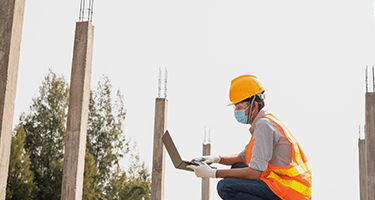A Guide to Stop Work Orders for Contractors
Dealing with paper-thin margins and tight schedules is not the only nightmare for a contractor on a project. A minor violation of the building code can force a stop work order, leading to extended timelines, expensive penalties, and more customer frustrations. This article covers what you should know about stop work orders and we share how easy-to-use construction jobsite management software can better manage contracts and work orders.
What Is a Stop Work Order in Construction?
A stop work order (SWO) is a legally binding instruction given to a contractor, asking them to suspend all work on a project. The order may be given by word of mouth, but it’s only enforceable when confirmed in writing. Stop work orders may apply in any project with a written contract, but they’re more common in the construction industry. When issued, the contractor should cease all project-related activities immediately.
What Are Common Reasons for a Stop Work Order?
When a project fails to comply with the building code, the authorities can issue a stop work order. The orders also help to solve payment disputes, and they can help reduce the extent of damage in breach of contract. Here are more reasons why you would get served with one:
- Failure to comply with workers’ compensation regulations
- Using unlicensed contractors
- Violating environmental protection laws or use of hazardous materials at the construction site
- Failure to follow the Occupational Health and Safety Act
- Any other activity considered illegal according to the regulations
Who Can Issue a Stop Work Order?
The authorities and anyone who’s part of the contract can request a stoppage. Government agencies will recommend a work stoppage for noncompliance with the regulations. Sometimes a project may move according to plan, but the requirements change midway, forcing modifications that might need government approval. A stop work order can also help when a client or contractor disputes when one party changes the agreed terms and substantially alters the final product. Workers can also ask for suspension of operations to resolve a payment dispute.
What’s Included in a Stop Work Order?
A stop work order will describe everything that needs to be suspended and provide clear instructions on fixing it. Here is what you can expect to find in the document:
- Details of the activities suspended. It could be a section of the works or the entire project.
- Clear instructions on the corrections needed. For example, the authorities can order a contractor to obtain a permit for renovation work before continuing with the project.
- Resolution: The SWO should provide the steps for work resumption should the contractor make corrections that meet the requirements.
- Termination: If it seems like no amount of rectifying will resolve the problem, like when the project owner and contractor have irreconcilable differences, the stop order should outline the steps for termination.
- The SWO should also explain the penalties for non-compliance. They could include consequences like prosecution, civil fines, termination of the contract, and others.
What Types of Stop Work Orders Exist?
Not all stop work orders require you to abandon the construction site completely. The authorities might issue a full or partial stoppage depending on the potential impact of the issue at hand.
- In partial SWO, you will halt some activities and continue with the rest of the work. For example, a partial PWA can be issued to make you address the safety issues of a section of your construction as you continue working on other sites.
- A full SWO stops the entire operation. It’s usually used when it’s found that you need to address serious issues affecting your entire project, like a change in technical specifications or non-compliance with regulations.
What Should You Do When You Receive One?
A stop work order may cause unnecessary delays and possible prison time for legal noncompliance. You also don’t want to spend your time fighting legal battles for money that could have been more useful in your project.
Here’s what you need to do when you get an order to halt operations:
- Stop working immediately, or you could face serious penalties from the authorities.
- Contact the issuing authority to seek further clarification if you need to.
- Review the issues raised to confirm any violations. Contact your lawyer if you feel the order was raised unfairly.
- Determine the cost and extent of the work needed to make corrections. You can decide whether termination makes more sense than continuing the project.
- Create a work plan and fix the issues.
- Start the process of having the order by requesting an inspection of the work done. Sometimes the SWOs are lifted by the expiration of time.
- Pay the fines if you have to and resume your project.
What Are the Penalties for Not Following a Stop Work Order?
You should brace yourself for heavy fines and penalties from the authorities if you decide to ignore a stop work order for noncompliance. Across many states in the US, civil penalties start to accumulate from the first day you violate the SWO, building up to a hefty sum that you might struggle to pay. Noncompliance may also bring criminal charges, not forgetting the time spent sitting in courts or dispute resolution sessions.
What is an Example of a Stop Work Order?
A stop work order will be very specific to the violations in your project. State departments and city authorities can issue stop orders for many reasons. For example:
Failure to Comply With City Zoning Regulations
- Unsafe activities at a job site, for example, a tunneling project with extremely loose soil above ground
- Extreme modifications going against what was previously approved for a project
A project owner who wishes to have similar powers to halt operations should ensure that they include a stop work order clause in the contract.
How Do You Resume Work?
Stop work orders are costly to the project, and contractors should prioritize resuming normal operations as fast as possible. Work may start again when the order is canceled, expires, or the authorities send a written notice to continue working.
Here’s what you need to do if you want to lift the order quickly:
- Handle the corrections immediately. The best solution is to clean up your mess as soon as possible to avoid penalties and further delays.
- Request for re-inspection from the issuing authority. It’s going to be thorough, so ensure that you’ve done a pretty neat job this time.
- Pay the applicable fines.
Preventing Stop Work Orders From Disrupting Your Construction
Running a construction project is a tough job, and it would be regrettable if a stoppage should get in the way of meeting your schedules. It is always a good idea to comply with all the building codes and environmental regulations in your area. Try to maintain good relations with all of the stakeholders in your project.
Ensure that you document everything, and it might help in your defense should you run into legal troubles. However, all this is easier said than done, and you may benefit from having construction management software to keep up with all the requirements.
What is Construction Management Software?
Construction management software is designed to integrate with different aspects of construction work like contract management, threat analysis, stock management, cost management, client management, task management, and much more.
Construction management software can help contractors at different levels to keep tabs on every part of the project, helping them with compliance, avoiding contract disputes, and curbing illegal or substandard work.
Benefits Managing Construction Contracts and Work Orders With Software
As a contractor or project manager, you will have a much easier time navigating SWO-related issues when you have software to help manage work orders, contracts, inspections, and similar workflows between the field and office.
For example, you will have all your contracts in one place where they’re easily accessible, and you can track and avoid changes that might cause a stop work order. Here are some of the benefits of using software for construction:
- Planning. It’s much easier to staff your project and equip them with the right tools when you have effective planning software. Having the right people doing the work with equipment that serves them sufficiently lowers the chances of doing substandard work and accidental injuries caused by insufficient tools.
- Communication. Effective stakeholder engagement is one of the most critical roles for any project manager. However, poor communication is one of the biggest hindrances, and it causes many contractual disputes. The major challenge is how to process the tons of information coming in from different sections and share it effectively with the owners, the workers, and the authorities. The software provides timely alerts and useful communication tools like reports and analytics that you share with the stakeholders as needed.
- Documentation. Imagine being unable to trace your safety reports or having a hard time accessing your building permits. Document management can be one of the hardest things to do, and software keeps everything in one place so you can focus on your deadlines instead of paperwork.
- Safety. Incorporating software into your construction project brings more awareness to safety-related issues. They can help you identify possible risks and plan for safety guidelines to minimize worksite injuries and stop work orders.
- Monitoring. Construction management software gives you more eyes over the project, making it easy to keep everyone accountable for their work and monitor your operations from anywhere. Greater visibility into your field operations can allow you to spot issues, trends, and other information that can be difficult to report on without the help of digital technology.
Software To Manage Contracts & Work Orders
GoCanvas provides an easy-to-use platform for managing your contracts, work orders, inspections, safety programs, quality control, and much more. Contact our team to schedule your demo.

Stay in Touch!
About GoCanvas
GoCanvas® is on a mission to simplify inspections and maximize compliance. Our intuitive platform takes care of the administrative tasks, freeing our customers to focus on what truly matters – safeguarding their people, protecting their equipment, and delivering exceptional quality to their customers.
Since 2008, thousands of companies have chosen GoCanvas as their go-to partner for seamless field operations.

Check out even more resources

The Ultimate Guide to Quality Control Inspections
Managing a construction project is a complex and stressful process. Among other things, you have to coordinate project team members, materials, and equipment and ensure that contractors are not afflicted by the potential risks and hazards present at the construction site. That said, quality means different things to different people which is why you should…

Constructions Digital Transformation
Your competition is finding faster ways to capture data and get critical insights from the field into their existing systems. In short, they’re not going bigger, they’re getting smarter. In this 15-minute broadcast on the construction industry’s digital transformation, find out why the trend is to modernize workflows – and how you can stay ahead of the curve…

See how VIP Lighting optimized efficiency with GoCanvas
VIP Lighting is a retail lighting and electrical maintenance business that services over 10,000 retail locations all over Australia and New Zealand. Before GoCanvas, VIP Lighting had two separate systems that were impossible to integrate, leading to inefficiencies. GoCanvas made it easy to integrate their systems into single, centralized platform…